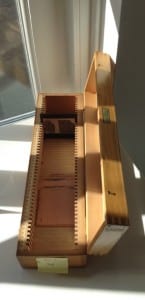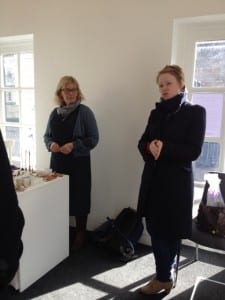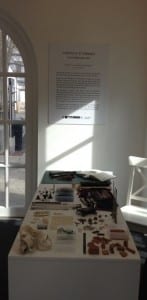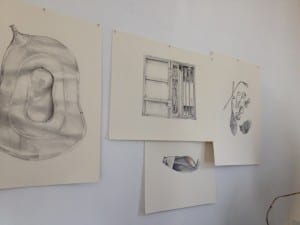Sawdust and Threads
by Laurie Ingram, Material And Visual Culture, UCL
“Sawdust and Threads is a residency and exhibition programme that takes de-accessioned museum objects as its material. Artist Caroline Wright has undertaken residencies at three different museum collections and selected objects that have been de-accessioned. For Sawdust and Threads, Caroline has made detailed drawings of each of these objects that are then carefully and painstakingly deconstructed. The drawings, as well as the objects from the different collections, accompany the artist in the space where the process of deconstruction unfolds. The project poses questions around the nature of museum collections. Who owns these objects and how is the value of an object defined? Is value being removed or re-ascribed during this process of deconstruction? The project was conceived by artist Caroline Wright and Norwich Castle in partnership with the Polar Museum in Cambridge and UCL Museums and Collections.” (exhibition blurb)
UCL Ethnography Collections donated an empty wooden box, once used to house lantern slides that are now housed in archival paper boxes, and duplicate lantern slides. These objects are currently considered redundant because of the growth of conservation principles and digitisation as epistemologies within this teaching collection.
From their primary use to museum display to storage, some objects eventually find themselves fated to become de-accessioned for one reason or another. A fascinating approach by the ‘Sawdust and Threads’ exhibition has posited another stage to this process of disposal. This new stage extends the value of unwanted objects, which are recorded in pencil sketches before being carefully disassembled by hand and displayed in their own disarray. This process can reveal new or lost information about these objects, showing how objects can illuminate their own histories.

Members of the Material & Visual Culture MA programme had the opportunity to meet and talk with the artist and curator of this exhibition, which could also be described as an art performance. Walking into the exhibit, a large ball made of woven wicker covered with chipping black paint dominates the space. It is in the process of being taken apart by the artist, Caroline Wright, who explains the story that exists within this object. This wicker ball would have been placed on a ship and when raised on a mast would have signalled danger. The black paint itself suggests that the ball could have belonged to a ship made for polar expedition, as its colour would contrast with the white surroundings. Caroline has begun to dismantle the ball, with strands of wicker lying in wavy circles beneath her desk.
As well as this, she demonstrates an object in its final stage of dismantling – a wooden medical box that has been taken apart and sanded down to reveal beautifully red sawdust that, once bagged, is soft enough to rest one’s head. Using only handtools, Caroline’s physical efforts have illuminated these new material properties of the wooden box. It is a treasure to discover that the sawdust retains such vibrant colour, suggesting that it was not just varnish after all, but the substance of the wood itself.
Before disassembling, Caroline pencil-draws the objects in their final moments of wholeness, and explains that this allows her greater insight into the lives of these disused objects. The visual medium of drawing allows for a certain personal connection to the object that photography alone can miss. The close observation and attention to form allows the artist to explore the object in an intimate way. For example, her sketching has revealed the subtle creases on a deflated rubber bedpan; alluding to how this object may have once been stored, perhaps folded away in a drawer.
This thought-provoking exhibition reveals a hidden step in the life of museum objects. While museums take great care in de-accessioning objects, ‘Sawdust and Threads’ demonstrates that even objects deemed no longer necessary still have much to tell us about themselves. Despite encountering these objects with little information, and by exploring their material form through artistic expression, it becomes possible to redeem qualities of value that could have otherwise been overlooked. The deconstruction of these objects, while irreversible, becomes a part of a creative process that further pieces together their pasts and fleshes out the narratives of their lives.




[…] is the second time UCL welcomes an exhibition from Caroline Wright on Sawdust & Threads. Here you can find some information on the first […]